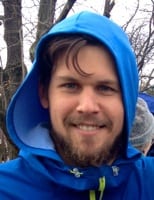Beginning on September 12th, 2016 and finishing on October 24th, Pete Kostelnick ran from San Francisco City Hall in California to New York City Hall in New York in a record-setting 42 days, 6 hours, and 30 minutes. In doing so, the financial accountant shattered the previous longstanding record of 46 days, 8 hours, and 36 minutes set in 1980 by Frank Giannino, Jr. In running a total of 3,067 miles, Pete averaged more than 70 miles per day—and ate between 9,000 and 15,000 calories daily—for seven consecutive weeks. What prompted his remarkable effort? How did he manage to run nearly three marathons per day for 42-straight days? In this interview, Pete discusses his relationship with running, the challenging aspects of his record-setting run, and some of his future goals.
iRunFar: What you accomplished will seem nearly impossible in the minds of most readers. You ran nearly three marathons a day for six weeks. How do you wake up on a given day and get your mind around that? What’s that mental process like?
Pete Kostelnick: [laughs] Yeah, yeah. Each morning was probably the worst part of my day. You know, waking up knowing I have to be out the door in 30 minutes. I usually woke up at 3:30 a.m. and tried to get out the door by 4:00. It wasn’t pretty but I would say the saving grace was that—I always tell people that the first mile is the hardest one. The sooner you get that first mile out of the way, the sooner you can, I guess, enjoy the rest of the day [laughs].
So that was always my mantra waking up: It’s going to suck, but the quicker I get up, the quicker I have breakfast, the quicker I get out the door, the sooner I’m going to be in a better spot, a better place mentally. I think using that sheer hatred [laughs] of getting up and trying to minimize the pain and rip off the Band-Aid as quickly as possible was really the only thing that would get me out of bed each morning [laughs].
iRunFar: Did that at times necessitate urging from your crew members?
Kostelnick: I was pretty good. I don’t think there was ever a time where they had to pester me to get out the door—that was the good part of it.
iRunFar: Were there any emotional bouts—crying or getting angry?
Kostelnick: I would say during the day, when I was out there, I was pretty even-keeled. But starting and sometimes even ending the day, I definitely had my moments. I think there’s a picture of me on the second day where I was actually laying on the pavement because of a temper tantrum I had. I thought I was done for the day and I found out I had one or two miles left going up a steep mountain road [laughs]. I spiked my water bottle down and lay there for a couple of minutes and complained about it. After that I got better, I think. I quickly learned that I couldn’t do that any more if I wanted to—you know, from a pure health standpoint, if I was throwing things and laying on the ground and doing all these things, I wasn’t going to last very long. I think as the run went on I definitely matured a little bit in that respect.
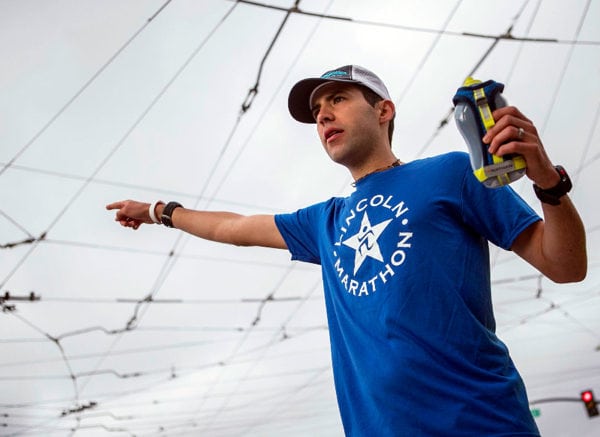
Just 45 minutes into his record run, Pete is interrupted by construction in California. Photo: Zandy Mangold
iRunFar: What were your expectations going into the transcon run?
Kostelnick: From a recovery standpoint, I was almost too confident coming in. I went out really hard on this [transcon run]. Part of it was that I wanted to stir up some excitement around the run. But it was—I was looking at it from a seven-day perspective rather than a 40-plus-day perspective. The first two days I went out and did 80 miles both days. It just wasn’t smart. I was really treating each day as, Okay, I’ll run until I’m spent, I’m completely drained, and in the morning I’ll be fine, it might just take me a little bit to get going. It wasn’t a very smart strategy [laughs], to say the least, and then I ended up digging myself a hole by the end of the week and I had to take a day completely off when I developed some pretty bad tendinitis in the ankles. But going into it I was probably a little overconfident and a little over zealous. I started banking miles early and it ended up biting me by the end of the week [laughs].
iRunFar: How many miles did you run in the first week?
Kostelnick: I was at 450 miles on the dot through six days and then I had to take the seventh day off. It’s interesting because every week after that I was at 500 to 510 miles each week. So even though my average daily mileage went down after those first six days, I was doing more miles per week.
iRunFar: The stated goal seemed to be to break the record of 46 days. In your mind, did you have an exact number that you thought was achievable?
Kostelnick: Yeah I told everyone that 44 days was going to be the goal. That was roughly 70 miles per day. It’s kind of funny because I had a 42-and-change goal in the back of my mind because that’s about a 72-mile average per day. When I was doing calculations I would use 72 instead of 70 because I was thinking in my head that I might be able to get to 72. It was such an even number because it’s basically three miles per hour if you took 24 hours in a day, even though I wasn’t moving 24 hours per day. In the back of my mind I was thinking just under 43 days, although I didn’t anticipate taking a day off—but then I also didn’t anticipate some of the higher-mileage days to start.
iRunFar: It’s one thing to think you can do something. It’s another to have done it and look back on it. Typically your perspective will change. Now that you’ve accomplished what you thought you could, has it surprised you that you actually did it?
Kostelnick: Honestly right now I look at it as I did basically what I thought I could do, although I know that even maybe a few months from now or a year from now, when I look back on it, it’ll be, Wow! I can’t wait to look at the data stitched together on Strava—maybe that’s when it will hit me. For a lot of this run it felt like I was running inside on a treadmill. The country was kind of just moving behind me [laughs]. So I think it really won’t hit me for a while, the craziness of it, I guess [laughs].

For 42 days, Pete pounded pavement like he does here in Nevada. Photo: Zandy Mangold
iRunFar: You woke up at 3:00 or 3:30 a.m. each morning, you were running by about 4:00, and that lasted until 5:00 p.m. except for about a 30-minute break in there. It was very methodical. Do you think that methodical approach was necessary to achieve what you did?
Kostelnick: I think so. Mentally it was a lot easier to get the miles done knowing that the day was going to be done at a certain time. When I went out the first couple days it was like, Well, I’ll finish whenever I finish. That was a pretty tough pill to swallow, especially with doing three segments each day instead of two.
I would start the run and do two longer segments—a marathon to 50k—then one shorter segment, like 10 miles or so. That third segment, to get out of the RV and do it, was just pain all around [laughs]. So I think getting a clear picture that I start every day at 4:00 a.m. and try to get to 70 or 75 miles a day. During the afternoon I would do calculations and it started to get a little fun because I’d say, okay, I got 20 miles left on the day and I have four hours to do it, which means I only have to average a 12-minute mile pace, which means I can basically walk half those miles. I think that was what got me through each day, just knowing that in the morning I was pushing a little harder and trying not to walk at all, so that by the time I got to the afternoon miles I could start to have a little fun and mix in a little walking and enjoy some of the sights around me and start focusing on the next day already.
iRunFar: Do you think the biggest challenges were mental or physical? And what were those challenges?
Kostelnick: I would say out west it was definitely more physical because I wasn’t even thinking about the end, I was just thinking about each day. Mentally I was actually pretty sharp but I definitely had those issues with tendinitis. I would say the biggest challenge of all was when I got to Pennsylvania. You know, everyone is getting excited, I was pretty much off the grid but I could tell that a lot of people were excited for me to finish, but then I just kept thinking to myself, Wow, I still have 400 miles to go [laughs]—that’s not a short run at all, even though everyone was like, “Oh, you’re almost there, you’re 90% there.”
Yeah, Pennsylvania completely shattered my mental state and to make matters worse, it was right after I had been running on a nice flat road for several states—all the way from Nebraska. And so the hills weren’t my strengths—I’m a very rhythm runner. When I can’t get into a rhythm and zone out at a pace—whether it’s going uphill for an extended period of time or just flat. Pennsylvania has such weird, crooked hills that there were some miles that I’d be walking then running three different times within a mile. It was really frustrating and then there were downpours of rain for a couple days, so that was definitely the hardest part of the journey, getting through that dang state.
iRunFar: I guess you won’t be returning there any time soon for a jog.
Kostelnick: [laughs] It’s just a crazy state because there are no good highways either. You have I-80 but you can’t run on interstates so I think I turned on a different highway every probably four or five miles on average. Zoning out and running straight ahead is one my biggest strengths. Running across Nebraska was pretty easy for me because you see the same thing over and over and my mind can go elsewhere, outside of running.

Day or night, Pete ran and his crew took care of the rest. Photo: Zandy Mangold
iRunFar: Your crew must have been an essential part of your success.
Kostelnick: Yeah, the crew was huge. I would have to say, a lot of the ultramarathons I’ve done have been ones that are really a crew-oriented atmosphere: Badwater and Desert Solstice. And so as crappy as I probably treated them from time to time because I’m not feeling so hot, they were amazing. We had a really good system down. Chuck Dale and Dean Hart, who were two of the four with me the whole way, they would leapfrog every two miles all the way across the country, and they would provide me with food and water and drinks. Then Cinder Wolff, she was the RV driver, but she was also an amazing massage therapist. That was probably one of the biggest things too, the stretching and the massaging she provided. It was paramount to my recovery and my ability to go out there and run each day. And then Trasie Phan—she gave us piece of mind because she took care of all the things that we didn’t want to take care of. She took care of all the logistics and the scouting out the route, so we felt confident about the route as we approached each day.
iRunFar: Were there ever significant issues with the route?
Kostelnick: No, it was actually pretty seamless. We were very lucky. My sister, Ann, she’s a schoolteacher, and she was actually our remote route guru. She was always in contact with department of transportation (DOT) personnel because there were several areas with construction going on, it would go down to one lane, so she was always contacting the DOT and people on site so that they were cool with me sneaking through some of their construction sites. We got that to work out pretty good.
iRunFar: Was there anything that really helped get you through the run?
Kostelnick: One of the biggest mental helps was when I had people to run with, it really helped get my mind off of running. Sometimes I wouldn’t even be in the mood to talk to someone but then I would start talking with them and you just can’t help but get caught up in conversation. That was one of the things that saved me mentally, and that was why Pennsylvania, for a couple days, was really, really hard—I was used to running with people in the Midwest once I got out of some of those lonely states out west. Pennsylvania kind of got lonely there again for a couple days and I think that was probably the biggest mental challenge, not having anyone to talk to for a while.
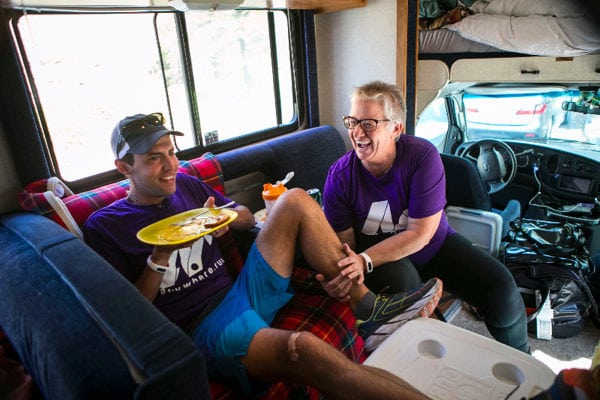
Cinder Wolff took care of Pete’s muscles and stomach for six weeks. Photo: Zandy Mangold
iRunFar: Since you’re from the Midwest, I guess you had an outpouring of support there.
Kostelnick: Yeah, yeah. I told people that it was an unfair home-field advantage. That middle part of the run, or the two-thirds mark, where people probably start to feel fatigued mentally, that was where I had tons and tons of people coming out to see me, and a lot of friendly faces, so that was so helpful to get me through some of those critical days before I saw the light at the end of the tunnel.
iRunFar: Let’s take a step back. You were born in Iowa, you previously lived in Nebraska, and now you live in Missouri. You’re a Midwest guy.
Kostelnick: Yeah, I’ve kind of been all over the Midwest. I lived in Kansas City for a few months, too, before I moved to Lincoln four or five years ago. Yep, can’t seem to get out to the West Coast at all [laughs], but that’s all right.
iRunFar: You ran cross country in high school. What got you into it?
Kostelnick: It was always something that I was kind of fascinated by. The reason I got into running was because I did some family trips out to Colorado and California. Most notably to summit Mount Elbert and Mount Whitney. It’s funny because those two mountains are part of two of the most iconic ultramarathons, Leadville and Badwater, both races that I’ve run although I DNFed at Leadville last year. So it’s come full circle. My uncle, when we were hiking in Colorado, told me, “Oh, if you love hiking 14ers so much, you should do cross country.” So eventually I signed up junior year of high school.
iRunFar: Once you got to college, you gave running up. What was your relationship with running like?
Kostelnick: I improved a lot [in high school] but I wasn’t very fast. I was a pretty casual runner. I took it seriously but I wasn’t faster than maybe 18 minutes for the 5k. I was decent but I wasn’t by any means a great runner.
It was more of a hobby and when I got to college I had such a weird schedule. I was probably taking too many credits and I was working about 20 to 30 hours a week as well on the side. I got into this mode of, Oh I don’t have time to run. It really wasn’t until my senior year of college when I was doing an internship out in Washington, D.C. where I had a much more routine schedule with a day job of 8:00 a.m. to 5:00 p.m.—it was out there that I finally said, “Okay, I need to get back to running because I’m probably 30 to 40 pounds heavier than I was in high school.” So it was a realization that I needed to get in shape and get into something. I got the marathon bug from people talking about the Marine Corps Marathon out there. I signed up for that—I was there from June until the end of the year. So I built my mileage up and had my eye on the Marine Corps Marathon, which is the last weekend in October. I got in decent shape but not crazy-good shape. I did that marathon and that gave me the marathon bug, checking the marathon off the list while I was out there. That was in 2008.
iRunFar: Looking at your results, you dabbled in some shorter ultra distances for the most part until 2013 or 2014. You had some good results but nothing exceptional. Then you get to July 28th, 2015 and you see ‘Badwater, 1st place, 23:27.’ From there on it’s like you’re a different runner.
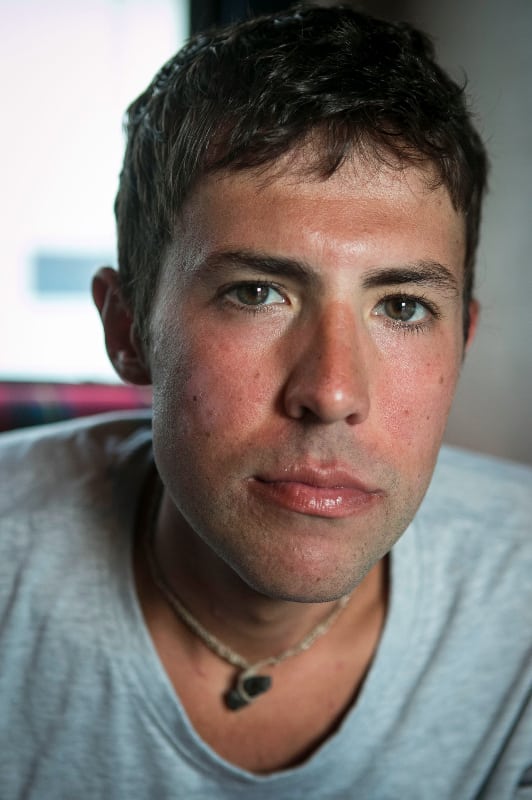
Pete Kostelnick, the day before completing his run across the country. Photo: Zandy Mangold
Kostelnick: Yeah, definitely. If you look at my marathon time, it increased pretty linearly. I was a three-hour marathoner, or just over three hours, until 2013 and then I started to dip under and 2:41 was my PR in 2015. I think there were several factors, especially for the 100 milers. I improved on my marathon and some of the shorter distances between 2013, 2014, and 2015. But it was really the nutrition part that I wasn’t getting for the 100 milers for the longest time. I would always get to the 100k mark and I would hit this nutrition wall where I couldn’t stomach anything anymore. I was always having issues and my legs were always more fatigued, I think, until I found out about Hokas.
Going into 2015, I was probably 15 to 20 pounds lighter than previously as well—that was one big shift that I made between 2014 and 2015 in particular. Switching to Hokas has really—more so than saving my legs during a race, it’s allowing me to add a lot of miles to my training. Prior to 2015 I was pretty high mileage—around 100 miles per week—but really in 2015 and 2016, training for Badwater and Western States and the transcontinental run this year, I’ve been doing more of 150-, 200-mile weeks, and some over 200 miles. The big change was that I was putting in really high mileage and was able to stay healthy these last couple years. As a result of that I’m eating a lot more calories so I think my stomach is really efficient at turning over food to energy—that was really big for transcon. I never had an issue with my stomach because I think it was really used to calories because I was eating so much [laughs].
iRunFar: That almost makes it sound too easy. It sounds like you’re saying that if you nail your nutrition and run a bunch of miles, you can win Badwater and set a record for running across the country.
Kostelnick: I think part of it has been—I’m not the lightest runner in the world but a lot of it has been that I’m 15 or 20 pounds lighter than I was. But a lot of it I have to contribute to the mileage. I think it’s the mileage. It’s pretty simple—I’m not coached by anyone or anything like that, so it’s been a pretty simple formula. I really don’t have a whole lot to it. I do a lot of treadmill training, so I think that’s also helped save my legs and allowed me to train without injury, but at the same time it does hurt my ability to race on trails. You look at my run at Western States this year—I don’t necessarily think I had a bad race—it’s just that my body is so… it’s very specific training, I don’t really do any side-to-side running. Pretty much everything is on a treadmill, or rail trails, or roads—everything is straight, forward motion with all my training.
iRunFar: You ran across the state of Iowa in 2013. Was that the impetus for something bigger, like the transcon run?
Kostelnick: That was part of—there’s this bike ride in Iowa and it’s 10,000-plus people. I think it’s actually the largest recreational bike ride in the world. It’s mostly an excuse to drink beer all day and bike a little [laughs]. I decided to run it because I don’t think anyone had run it before. There was one other guy who ran it as well, so we were the first two to run it during the seven-day bike ride. I think it was about 420 miles—basically it was 100k each day.
iRunFar: Was it in your mind then that you’d someday want to run across the country?
Kostelnick: Yeah, at that time, I thought about—I mean, it was tough. I think some people don’t get the right impression because I was doing it with the bike ride—I could have done more miles per day. But at the same time, I was done. I was doing Leadville two weeks after that and that’s where I DNFed at Leadville. I literally couldn’t do any running for the next two weeks. I think it was because I didn’t train as much back then. I was more of a 100-mile, 80-mile-per-week runner, so my legs weren’t ready for something like that.
People were saying, “Oh, you just take that times seven or eight and you can run across the country.” And I was like, “There’s no way I could run 100k a day for 50 days.” At that time, that was my big thing and I didn’t have any aspirations at that time to go for the cross-country record. And I was probably 20 or 30 pounds heavier when I did that.

Pete hugs his wife at New York City Hall on October 24th. Photo: Zandy Mangold
iRunFar: So what changed between 2013 when you ran across Iowa and this year? What pushed you to the point where you were willing to try it?
Kostelnick: Going into 2015, I really wanted to see what I could do. The first step was to cut 15 or 20 pounds. I also did a lot more training over the winter, going into 2015, than I had in the three years prior. I was very lucky, I didn’t have any nagging injuries finally, and I was able to piece together a really long training schedule that seemed to work out really well.
But I think it was after I won Badwater last year that I kind of considered myself pretty good at this ultra thing, especially on roads, and I remember talking to one of my buddies the morning after Badwater and saying, “Alright, remember that run across America I talked about? I think I’m going to need to go for the record here in the next couple years because I think I can do it if I have the right plan in place.”
iRunFar: It sounds like every step toward this transcon run was a question of, “What’s possible for me?”—to run the marathon, to run 100 miles, to run across Iowa, etcetera. Is that an accurate way to categorize it?
Kostelnick: Yeah, definitely. I don’t know what 2017 will bring, but I’m the type of person where I need to do something better than the last time. Each year I’ve looked at it as, If I did 100 miles per week last year, then I need to do 120 miles per week this year, and so on, and that’s kind of been my progression each year as I look forward to tackling new challenges and trying to better what I did the previous year.
iRunFar: You’ll have your hands full for 2017 then. You’ll run the IAU 24-Hour World Championships in July next year, right?
Kostelnick: [laughs] That’s probably the main focus for 2017.
iRunFar: Something like a world record there might one-up the transcon run?
Kostelnick: [laughs] Yeah, I don’t know, that 188, I don’t think my plateau reaches that high [laughs]. [Author’s Note: The farthest distance run in 24 hours is 188 miles. The great Yiannis Kouros set the record in 1997.]
iRunFar: Some folks think you’d perform quite well in a six-day event. Is that on your radar?
Kostelnick: Yeah I think the six day interests me. It might take a while for me to get to where I want to be just from a pure recovery standpoint. I think over the next couple years that might be a distance I go for at some point.
iRunFar: Pete, it was a real pleasure, thanks for taking the time to talk.
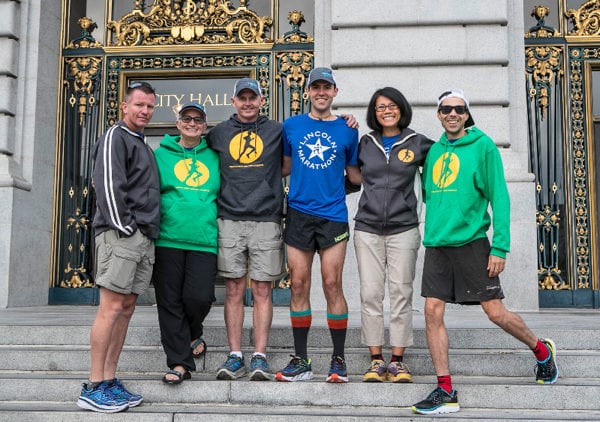
Pete’s crew (left to right): Dean Hart, Cinder Wolff, Chuck Dale, Pete, Trasie Phan, Zandy Mangold (photographer). Photo: Zandy Mangold
